The AMD Radeon R9 Fury X Review: Aiming For the Top
by Ryan Smith on July 2, 2015 11:15 AM ESTFiji’s Architecture: The Grandest of GCN 1.2
We’ll start off our in-depth look at the R9 Fury X with a look at the Fiji GPU underneath.
Like the Hawaii GPU before it, from a release standpoint Fiji is not really the pathfinder chip for its architecture, but rather it’s the largest version of it. Fiji itself is based on what we unofficially call Graphics Core Next 1.2 (aka GEN3), and ignoring HBM for the moment, Fiji incorporates a few smaller changes but otherwise remaining nearly identical to the previous GCN 1.2 chips. The pathfinder for GCN 1.2 in turn was Tonga, which was released back in September of 2014 as the Radeon R9 285.
So what does GCN 1.2 bring to the table over Hawaii and the other GCN 1.1 chips? Certainly the most well-known and marquee GCN 1.2 feature is AMD’s latest generation delta color compression technology. Tied in to Fiji’s ROPs, delta color compression augments AMD’s existing color compression capabilities with additional compression modes that are based around the patterns of pixels within a tile and the differences between them (i.e. the delta), increasing how frequently and by how much frame buffers (and RTs) can be compressed.
Frame buffer operations are among the most bandwidth intensive in a GPU – it’s a lot of pixels that need to be resolved and written to a buffer – so reducing the amount of memory bandwidth these operations draw on can significantly increase the effective memory bandwidth of a GPU. In AMD’s case, GCN 1.2’s delta color compression improvements are designed to deliver up to a 40% increase in memory bandwidth efficiency, with individual tiles being compressible at up to an 8:1 ratio. Overall, while the lossless nature of this compression means that the exact amount of compression taking place changes frame by frame, tile by tile, it is at the end of the day one of the most significant improvements to GCN 1.2. For Radeon R9 285 it allowed AMD to deliver similar memory performance on a 256-bit memory bus (33% smaller than R9 280’s), and for Fiji it goes hand-in-hand with HBM to give Fiji an immense amount of effective memory bandwidth to play with.
Moving on, AMD has also made some changes under the hood at the ALU/shader level for GCN 1.2. Many of these changes are primarily for AMD’s Carrizo APU, where task scheduling improvements go hand-in-hand with the AMD’s Heterogeneous System Architecture initiative and deliver improvements to allow the CPU and GPU to more easily deliver work to each other. Similarly, 16-bit instructions are intended to save on power consumption in mobile devices that use lower precision math for basic rendering.
More applicable to Fiji and its derivatives are the improvements to data-parallel processing. GCN 1.2 now has the ability for data to be shared between SIMD lanes in a limited fashion, beyond existing swizzling and other data organizations methods. This is one of those low-level tweaks I’m actually a bit surprised AMD even mentioned (though I’m glad they did) as it’s a little tweak that’s going to be very algorithm specific. For non-programmers there’s not much to see, but for programmers – particularly OpenCL programmers – this will enable newer, more efficient algorithms where when the nature of the work requires working with data in adjacent lanes.
But for gamers, perhaps the most significant architectural improvement to GCN 1.2 and thereby Fiji are the changes made to tessellation and geometry processing. There is no single silver bullet here – after going with a 4-wide geometry front-end in Hawaii, AMD hasn’t changed it for Tonga or Fiji – but AMD has put in quite a bit of effort in to improving how geometry data moves around within the chip and how it’s used, on the basis that at this point the limitations aren’t in raw geometry performance, but rather the difficulties in achieving that performance.
Much of this effort has been invested in better handling small geometry, whether it’s large quantities of small batches, or even small quantities of small batches. The inclusion of small instance caching, for example, allows the GPU to better keep small batches of draw calls in cache, allowing them to be referenced and/or reused in the future without having to go to off-cache memory. Similarly, AMD can now store certain cases of vertex inputs for the geometry shader in shared memory, which like small instance caching allows for processing to take place more frequently on-chip, improving performance and cutting down on DRAM traffic.
More specific to Fiji’s incarnation of GCN is how distribution is handled. Load balancing and distribution among the geometry frontends is improved overall, including some low-level optimizations to how primitives generated from tessellation are distributed. Generally speaking distribution is a means to improve performance by removing bottlenecks, however AMD is now catching a specific edge case where small amplification factors don’t generate a lot of primitives, and in those cases they’re now skipping distribution since the gains are minimal, and more likely than not the cost from the bus traffic is greater than the benefits of distribution.
Finally, AMD has also expanded the vertex reuse window on GCN 1.2. As in the general case of reuse windows, the vertex reuse window is a cache of sorts for vertex data, allowing old results to be held in waiting in case they are needed again (as is often the cases in graphics). Though they aren’t telling us just how large the window now is, GCN 1.2 now features a larger window, which increases the hit rate for vertex data and as a result further edges geometry performance up since that data no longer needs to be regenerated.
As with our R9 285 review, I took the time to quickly run TessMark across the x8/x16/x32/x64 tessellation factors just to see how tessellation and geometry performance scales on AMD’s cards as the tessellation factor increases. Keeping in mind that all of the parts here have a 4-wide geometry front-end, the R9 285, R9 290X, and R9 Fury X all have the same geometry throughput on paper, give or take 10% for clockspeeds. What we find is that Fury X shows significant performance improvements at all levels, beating not only the Hawaii based R9 290X, but even the Tonga based R9 285. Tessellation performance is consistently 33% ahead of the R9 290X, while against Tonga it’s anywhere between a 33% lead at high factors to a 130% lead at low tessellation factors, showing the influence of AMD’s changes to how tessellation is handled with low factors.


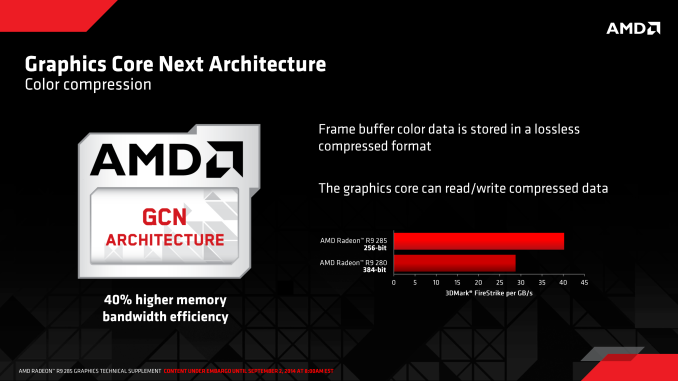
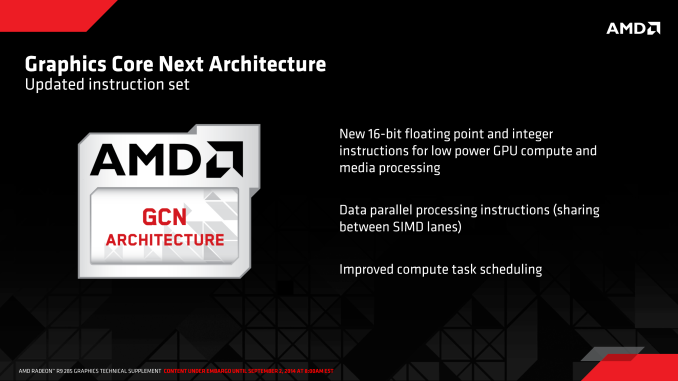
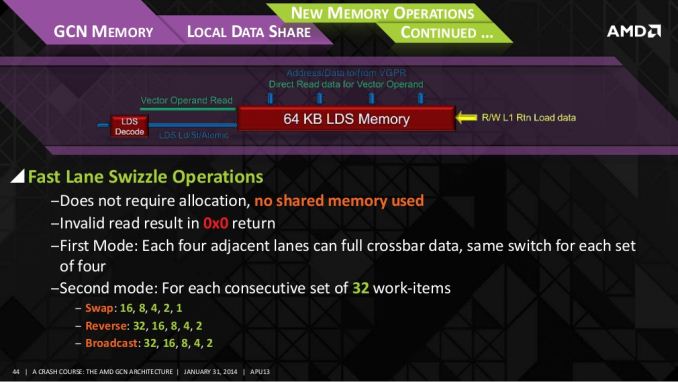
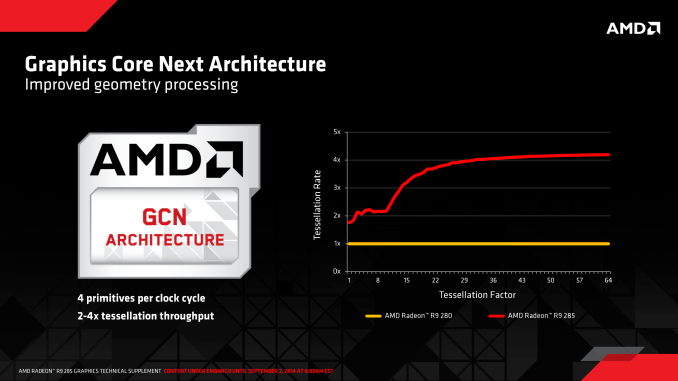
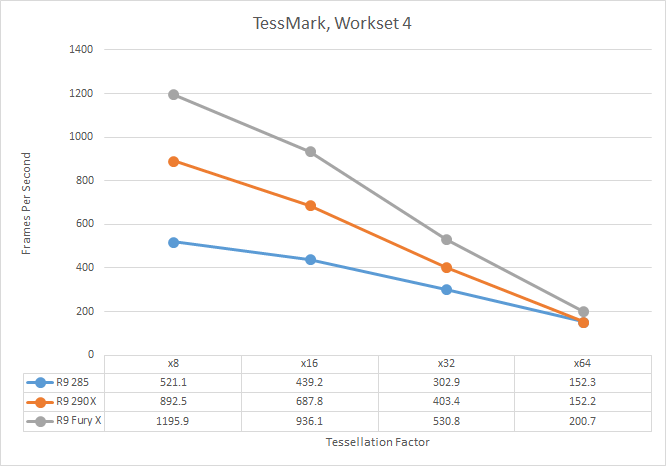








458 Comments
View All Comments
anandreader106 - Thursday, July 2, 2015 - link
@Wreckage Not quite. Cash reserves play a role in evaluating a company's net worth. When AMD acquired ATI, they spent considerable money to do so and plunged themselves into debt. The resulting valuation of AMD was not simply the combined valuations of AMD and ATI pre-acquisition. Far from it.AMD is the undisputed underdog in 2015, and has been for many years before that. That is why Ryan gave so much praise to AMD in the article. For them to even be competitive at the high end, given their resources and competition, is nothing short of impressive.
If you cannot at least acknowledge that, than your view on this product and the GPU market is completely warped. As consumers we are all better off with a Fury X in the market.
Yojimbo - Thursday, July 2, 2015 - link
Yes, NVIDIA was definitely the underdog at the time of the AMD purchase of ATI. Many people were leaving NVIDIA for dead. NVIDIA had recently lost its ability to make chipsets for Intel processors, and after AMD bought ATI it was presumed (rightly so) that NVIDIA would no longer be able to make chipsets for AMD processors. It was thought that the discrete GPU market might dry up with fusion CPU/GPU chips taking over the market.chizow - Thursday, July 2, 2015 - link
Yep, I remember after the merger happened most AMD/ATI fans were rejoicing as they felt it would spell the end of both Nvidia and Intel, Future is Fusion and all that promise lol. Many like myself were pointing out the fact AMD overpayed for ATI and that they would collapse under the weight of all that debt given ATI's revenue and profits didn't come close to justifying the purchase price.My how things have played out completely differently! It's like the incredible shrinking company. At this point it really is in AMD and their fan's best interest if they are just bought out and broken up for scraps, at least someone with deep pockets might be able to revive some of their core products and turn things around.
Ranger101 - Friday, July 3, 2015 - link
Well done Mr Smith. I would go so far as to say THE best Fury X review on the internet barnone. The most important ingredient is BALANCE. Something that other reviews sorely lack.
In particular the PCPer and HardOCP articles read like they were written by the green
goblin himself and consequently suffer a MASSIVE credibility failure.
Yes Nvidia has a better performing card in the 980TI but it was refreshing to see credit
given to AMD where it was due. Only dolts and fanatical AMD haters (I'm not quite sure
what category chizow falls into, probably both and a third "Nvidia shill") would deny that
we need AMD AND Nvidia for the consumer to win.
Thanks Anandtech.
Michael Bay - Friday, July 3, 2015 - link
Except chizow never stated he wishes to see AMD dead.I guess it`s your butthurt talking.
chizow - Friday, July 3, 2015 - link
Yep, just AMD fanboys ;)"What's Left of AMD" can keep making SoCs and console APUs or whatever other widgets under the umbrella of some monster conglomerate like Samsung, Qualcomm or Microsoft and I'm perfectly OK with that. Maybe I'll even buy an AMD product again.
medi03 - Sunday, July 5, 2015 - link
"AMD going away won't matter to anyone but their few remaining devout fanboys'So kind (paid?) nVidia troll chizow is.
chizow - Monday, July 6, 2015 - link
@medi03 no worries I look forward to the day (unpaid?) AMD fantroll's like you can free yourselves from the mediocrity that is AMD.chizow - Friday, July 3, 2015 - link
Yet, still 3rd rate. The overwhelming majority of the market has gone on just fine without AMD being relevant in the CPU market, and recently, the same has happened in the GPU market. AMD going away won't matter to anyone but their few remaining devout fanboys like Ranger101.piiman - Friday, July 3, 2015 - link
"AMD going away won't matter to anyone but their few remaining devout fanboys'Hmmm you'll think different when GPU prices go up up up. Competition is good for consumers and without it you will pay more, literally.